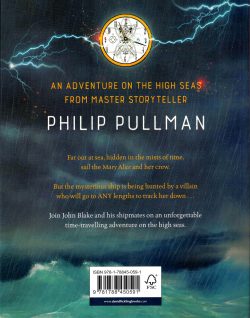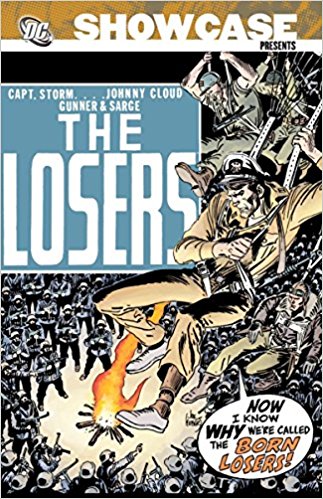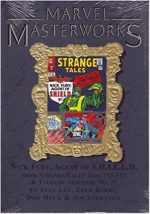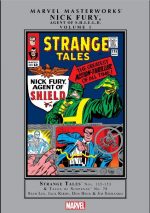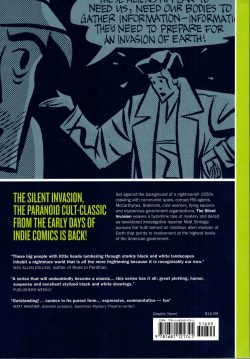

By Michael Cherkas & Larry Hancock (NBM)
ISBN: 978-1-68112-174-1
The 1980s were an immensely fertile time for English-language comics-creators. In America a fresh wave of creativity had started with the birth of dedicated comics shops and, as innovation-geared specialist retailers sprung up all over the country, operated by fans for fans, new publishers began to experiment with format and content, whilst eager readers celebrated the happy coincidence that everybody seemed to have a bit of extra cash to play with.
Consequently, those new publishers were soon aggressively competing for the attention and cash of punters who had grown resigned to getting their on-going picture stories from DC, Marvel, Archie and/or Harvey Comics. European and Japanese material began creeping in and by 1983 a host of young companies such as WaRP Graphics, Pacific, Eclipse, Capital, Now, Comico, Dark Horse, First and many others had established themselves and were making impressive inroads.
New talent, established stars and fresh ideas all found a thriving forum to try something a little different both in terms of content and format. Even shoestring companies and foreign outfits had a fair shot at the big time and much great material came – and almost universally, just as quickly went – without getting the attention or success they warranted.
By avoiding the traditional family sales points such as newsstands, more mature material could be produced: not just increasingly violent and with nudity but also far more political and intellectually challenging too.
Moreover, much of the “brain-rotting trash†or “silly kid’s stuff†stigma had finally dissipated and America was catching up to the rest of the world in acknowledging sequential narrative as a for-real, actual Art-Form, so the door was wide open for gosh-darned foreigners to make a few waves too…
One of the most critically acclaimed and just plain enjoyable features came from semi-Canadian outfit Renegade Press. They had spun out by a torturous and litigious process from Dave Sim’s Canadian Aardvark-Vanaheim enterprise, and set up shop in the USA before beginning to publish at the very start of the black and white comics bubble in 1984.
Renegade quickly established a reputation for excellence, picking up amongst others a surprisingly strong line of creator-based properties and some genuinely remarkable and impressive series such as Ms. Tree, Journey: The Adventures of Wolverine MacAlistaire, Normalman, Flaming Carrot, the first iteration of Al Davison’s stunning Spiral Cage autobiography and a compulsive, stylish Cold War, flying-saucer paranoia-driven thriller series entitled The Silent Invasion.
This last was a stunningly stylish retro-Red Scare saga bolting 1950s homeland terrors (invasion by Commies; invasion by aliens; invasion by new ideas…) onto Film Noir chic and employing 20-20 hindsight to produce a truly fresh and enticing concept in the Reagan-era Eighties.
The series was eventually collected as four superbly oversized monochrome tomes (a whopping 298 x 2058 mm), re-presenting the lead story from the first dozen issues of The Silent Invasion wherein co-creators Michael Cherkas & Larry Hancock concocted a delightful confection combining all the coolest genre elements of classic cult sci-fi, horror, spy, conspiracy theory, crime, romance and even comedy yarns…
Now, after far too long a wait – and with America once again enduring internecine struggle amongst the citizenry, corruption, collusion and cover-ups at every level of government and the press under attack from the people and traditions it seeks to inform and safeguard – the first two volumes have been re-released in a more manageable paperback size (or fully adjustable eBook format) with the expressed intention of catching up and finally completing the tensely compelling epic.
The 1950s in American were a hugely iconic and paradoxical time. Incredible scientific and cultural advancements, great wealth and desperate, intoxicating optimism inexplicably arose amidst an atmosphere of immense social, cultural, racial, sexual and political repression with an increasingly paranoid populace seeing conspiracy and subversive attacks in every shadow and corner of the rest of the world.
Such an insular melting pot couldn’t help but be fertile soil for imaginative outsiders to craft truly incisive and evocative tales dripping with convoluted mystery and taut tension, especially when wedded to the nation’s fantastic – and then-ongoing – obsessions with rogue science, flying saucers, gangsterism and espionage…
They were also obsessed with hot babes and bust sizes, but more of that elsewhere…
This first volume gathers prior collections Secret Affairs and Red Shadows and opens with Max Allan Collins’ expansive Introduction ‘Dick Tracy, Tintin and Serious Comics’, this titanic tale kicks off in April 1952 with ‘Chapter One: Atomic Spies’ within a dark desert landscape 22 miles outside Union City, USA.
Private eye Dick Mallet sees a strange light in the skies and in the morning the cops find his crashed car. There’s no sign of the infamous and distinguished Dick…
A month later reporter Matt Sinkage is still unhappy with his piece on “The Truth Behind Flying Saucers†but his mutterings and musings are interrupted by a hot blonde banging on the door of his foreign-sounding neighbour Ivan Kalashnikov.
Arriving at his desk on The Sentinel, Sinkage can’t believe the audacity of the Air Force’s official line about “marsh gas†and starts screaming at his Editor Frank Costello. The irascible bossman just bawls him out – again – and sends him off to cover real news…
Instead Sinkage heads out to the site of the latest sighting and starts interviewing local yokels. That night fiancée Peggy cooks him a meal but his mind is elsewhere, on that night six months back in Albany when he saw a UFO and impetuously chased after it: a night everyone but him remembers…
Later, in a bar, Matt continues badgering Frank until the booze gets to him. Eventually Sinkage slinks back to his apartment. Ivan’s door is open and a quick glance reveals the foreigner and others in front of a huge, weird machine and Matt realises they must be Reds! Atomic spies!
Before the reporter can react, Kalashnikov pulls a really strange gun and shoots. Next morning Sinkage awakes with another sore head and more fuzzy memories…
Days later Matt again collides with Mr K’s pretty friend Gloria Amber, but fails to get another look inside his neighbour’s place. Undeterred, he resorts to asking her out to lunch which somehow provokes the old guy into taking a sudden trip out of town. Things get even stranger when Gloria comes running to him, being chased by what she claims are Red agents…
Spiriting her away and stashing her somewhere safe, Matt doesn’t hear the pursuers accosting his landlord, claiming to be Federal Men…
‘Chapter Two: Secrets and Insidious Machinations’ finds the fugitives deep in the suburbs with Matt’s sedate brother Walter. The weary reporter is still seeing flying saucers and can’t understand why everybody else thinks they’re just jets. Meanwhile back in Union City, Frank is getting a grilling from FBI Agent Housley.
They’re old acquaintances. The G-Man regularly pops by to suppress one news item or another…
This time though the Feds want the vanished Sinkage and are not happy that Costello has no idea of the gadfly’s current location.
Back in suburbia, things are none too comfortable either. Stuck-up sister-in-law Katie is convinced Matt and his new floozy are up to no good and wants them out. At least she doesn’t know the FBI are scouring the city for them. Enigmatic Gloria, however, is more concerned that Sinkage is sleepwalking and having strange nightmares… just like Kalashnikov feared he might…
Matt and Gloria are just heading out in Walter’s borrowed car when Peggy pops by. She can’t understand why her man is with a flashy trollop and pointedly won’t talk to her. Gloria told Matt the real Reds are after Kalashnikov’s memoirs and convinced him to drive her to a quiet town in the desert where a “contact†will protect them both.
Mr K meanwhile has called in his own heavies to chase the couple, unaware that the FBI have visited Walter and Katie. A net is closing around Sinkage and the mystery woman he implicitly trusts… but really shouldn’t.…
The tension mounts in ‘Chapter Three: The Stubbinsville Connection’ as a mysterious Council of shadowy men convenes to discuss the Sinkage problem. As Housley’s report continues, when it becomes clear the reporter was also involved in the Albany event near-panic ensues…
In a cheap motel Matt’s suspicions are back. Gloria vanished from their room for a while during the night and hasn’t mentioned it…
They’re confirmed some time later when she helps Kalashnikov’s hoods Zanini and Koldst abduct her and rough him up. Back at Walter’s house the FBI turn up to interview them about Matt. They claim they’re the only Feds working on the case and no other government officials have been there before them…
Katie has had enough and spills all she knows. The agents instantly go into overdrive and organise all their forces to head for sleepy, remote Stubbinsville. Matt, meanwhile, has recovered and called the only guy he still trusts, his researcher Dan Maloney. That worthy warns him of the confusing profusion of agents all claiming to be working for the government, before sharing the same info with Frank Costello…
As Housley’s team fly in, Matt has decided to go on, hitchhiking to the rendezvous with a quirkily affable farmer who happily joins him in “pranking†the cops who have just arrested Zanini, Koldst and Gloria…
Reunited with his oddly-compliant mystery amour, Matt hurtles on to Stubbinsville in a stolen car, but with less than 100 miles to go Gloria falls ill. She makes him promise to get her there at all costs…
As the assorted pursuers converge, she directs Matt to a lonely wilderness area, but the forces of law and order have spotted them and follow. As the net closes a fantastic and terrifying lightshow ignites the dark skies. By the time Housley reaches the specified target area, all he finds is a comatose Sinkage.
As days pass, Matt finds himself free with all charges dropped, but he’s oddly content. Despite another blatant cover-up and no clue as to who all the various parties hounding him actually were, he knows what he knows and wonders when Gloria will be back…
By the time of ‘Chapter Four: A Pink Slip for a Pinko’ a little time has passed. It’s June 1952 and Matt Sinkage is tormented by nightmares of lights in the sky, Housley hunting him and Gloria beseeching him to join her kind…
His life has gone rapidly downhill. Stories of his being a “Commie†are everywhere, FBI agents shadow his every move and the oppressive tension is becoming overwhelming. When he gets a phone call from long-missing Dick Mallet, Matt arranges to meet the PI, and consequently notices that sister-in-law Katie is always listening recently and has become very chummy with his ominously ever-present G-Man surveillance detail…
First, though, Matt has to get the last of his belongings since the “Red†smear has allowed his landlord to terminate his lease. Aided by faithful fiancée Peggy and ever-friendly custodian Mr. Schneider, Sinkage collects his things and has an uncomfortable meeting with Kalashnikov. Almost in passing, Matt notices that he now has a different team of “Feds†dogging him.
When he finally meets Mallet, the gumshoe shows him an incredible set of photos: interior and exteriors shots of the flying saucers taken by the aliens…
At the Sentinel, Dan Maloney has made progress investigating Kalashnikov and Gloria but wants to finish his research before sharing. Sinkage has bigger problems though. His fellow workers have sent him to Coventry and the paper’s owner wants the “Commie†fired.
Costello is fighting back though. He suspects Housley is behind the disinformation and smear tactics targeting Matt.
Staying with Walter and Katie isn’t helping Matt’s mental state. As visions of the Albany event haunt him, his life takes another plunge when he finds Mallet murdered. Housley is there but frankly admits he knows Sinkage is innocent and (probably) the patsy of a cunningly contrived frame-up.
That doesn’t stop him trying to pump Matt for further information – just as his Council bosses ordered him to…
When Matt is finally fired and Maloney is killed in a freak accident the harried journalist knows is a case of Murder-By-Aliens, Sinkage feels the walls closing in and makes a run for it…
‘Chapter Five: Identity Crisis’ opens one night in July 1952 with Matt holed up in Maloney’s old hunting shack. He’s been utterly alone for weeks but is still seeing flying saucers in the night skies. He’s also reliving past events, helplessly mixing memories of Gloria with other moments. He’s so confused that when Peggy suddenly turns up, he mistakes her for his missing blonde mystery-woman…
Peggy visits him every night, offering food and company. She seems so different; warm and vivacious, but is always gone when he blearily wakes up in the morning.
Back in Union City, Housley and his secretary Meredith Monroe are reviewing the verifiable facts and reach a disturbing conclusion. Somebody on Phil’s team has their own agenda. He fears it’s his own boss – and Council stooge – Buzz Brennan but can’t find reasons to ignore their orders. Both his official employers and the secret ones above them want Sinkage found at all costs…
In the wilderness, Matt is starting to crack. Anonymously buying a gun from a local store he travels back to the city for Dan’s funeral and sees Housley and Brennan clash with Costello. He then sneaks back to his old building and breaks into Kalashnikov’s apartment. Sinkage finds a cache of files and as he reads them experiences a horrifying flashback: he’s strapped into some sort of brainwashing machine in a spaceship…
Matt is roused from the memories by Ivan’s return and bolts, leaving the scattered files behind. He then visits Peggy’s house where her mother’s hostile reception confirms a suspicion that has been growing in his mind…
His intended is waiting in the truck he borrowed, and as they furtively drive out to the country Matt drops his bombshell. He now believes he’s an alien consciousness improperly overlaid on a human mind and he knows Peggy is too: the same mental invader he used to know as Gloria Amber…
‘Chapter Six: What We Really Know about Flying Saucers’ pushes the drama into overdrive as Peggy frantically tries to dissuade Matt. He is adamant and, as Peggy storms off, Matt goes to Costello. They compare notes, unaware that the Council is mobilising all its covert assets in Housley’s FBI team to get Sinkage at all costs…
It might have worked had not Matt surprised everybody by turning himself in to share what he saw in Kalashnikov’s files with Housley and Meredith. Sadly, as he’s being taken to a safe-house Zanini and Koldst kidnap Sinkage and drag him back to Ivan… and Peggy!
By the time Housley realises what’s occurred and rushed to the apartment, it’s too late. The files are gone, but no one can determine whether they were cleared out by the foreigners or simply lost in the fire set by the Council’s inside man…
Matt has a different story. He survived the conflagration by rushing to the roof where he saw a saucer pick up one of his abductors, coldly leaving the rest to perish. It is a story he sticks to, even after he is committed…
To Be Continued…
Potently evocative, impeccably tailored and fabulously cool, The Silent Invasion remains a unique, boldly imagined and cunningly crafted adventure. Rendered in a style then considered revolutionary and even today still spectacularly expressionistic, this is a classic epic long-overdue for a modern revival: an unforgettable gateway to an eerily familiar yet comfortably exotic era of innocent joy and a million “top secrets†which no fan of fantastic thriller fiction should ignore.
© 1986, 1987, 2018 Michael Cherkas & Larry Hancock. Introduction © 1988, 2018 Max Allan Collins. All rights reserved.
Silent Invasion: Red Shadows will be published on September 25th 2018 and is available for pre-order now. For more information and other great reads see http://www.nbmpub.com/
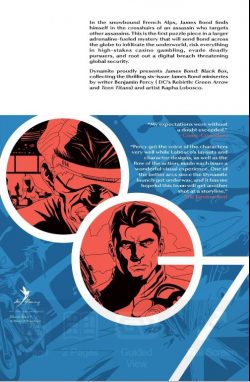


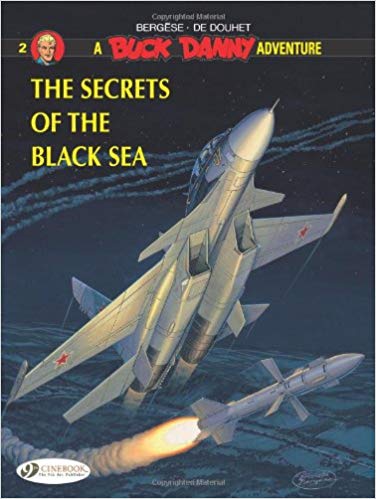
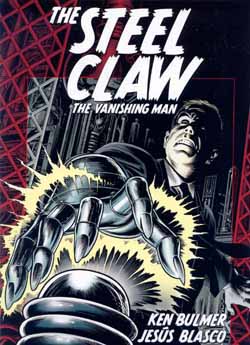 ,â€
,â€

